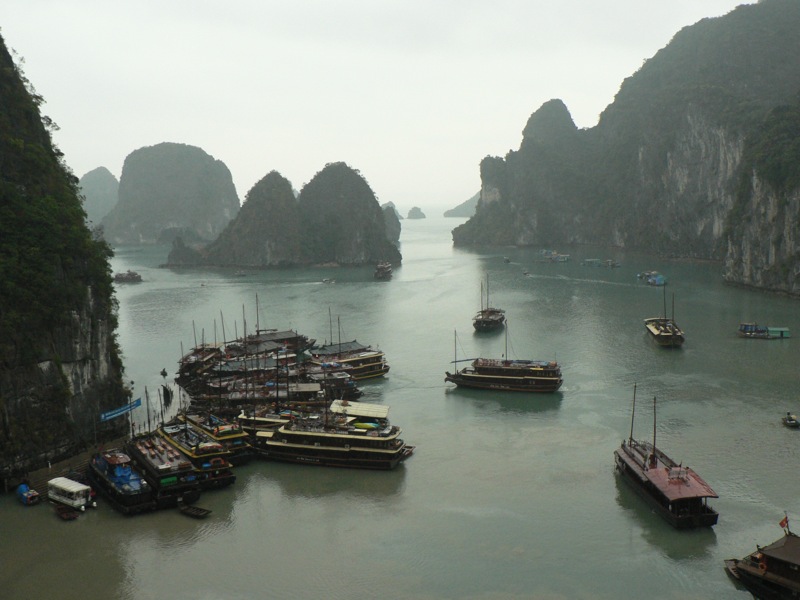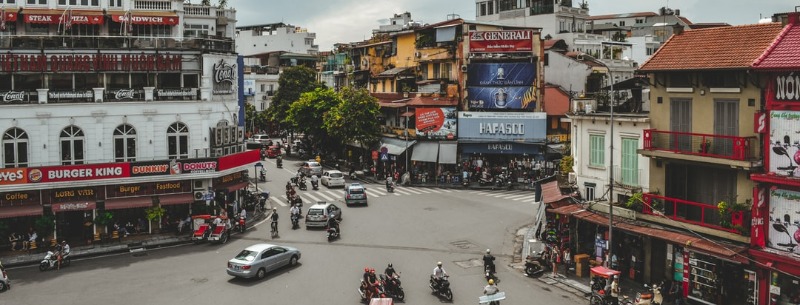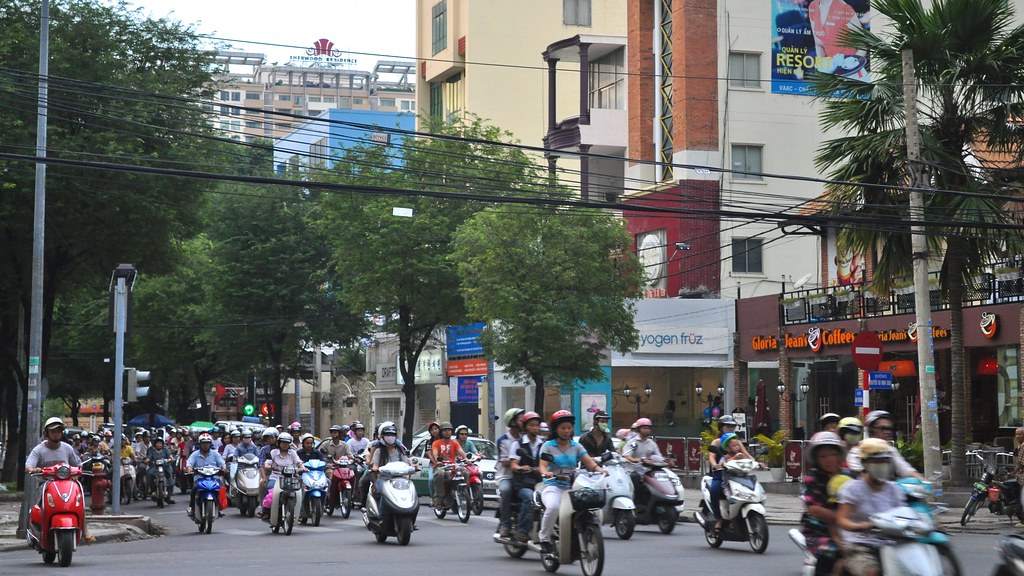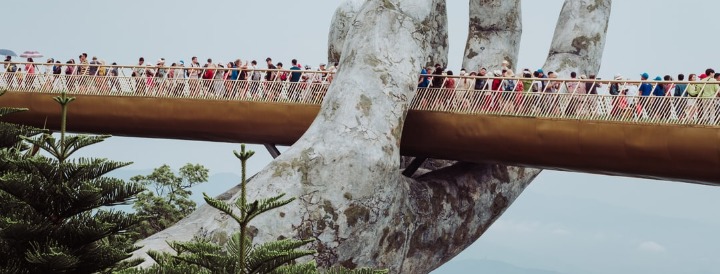2025 Vietnam Visitors Guide
History weighs heavily on Vietnam. For more than a decade, reportage of the war that racked the country portrayed it as a savage netherworld, yet, only twenty-odd years after the war’s end, this incredibly resilient nation is beginning to emerge from the shadows.
Tourism in Vietnam
As the number of tourists finding their way here soars, the word is out that this is a land not of bomb craters and army ordnance, but of shimmering paddy fields and sugar-white beaches, full-tilt cities, and venerable pagodas. The speed with which Vietnam’s population of 77 million has been able to transcend the recent past comes as a surprise to visitors who are generally met with warmth and curiosity rather than shell-shocked resentment and war fatigue. Inevitably, that’s not the whole story. The adoption of a market economy has polarized the gap between rich and poor: average monthly incomes for city dwellers remain at about $50 but drop to $15 in the poorest provinces.
For the majority of visitors, the furiously commercial southern city of Ho Chi Minh City provides a head-spinning introduction to Vietnam, so a trip out into the rice fields and orchards of the nearby Mekong Delta makes a welcome next stop – best explored by boat from My Tho, Vinh Long or Can Tho. Heading north, the quaint hill station of Da Lat provides a good place to cool down, but some travelers eschew this for the beaches of Vung Tau and Phan Thiet. A few hours’ ride further up the coast, the city of Nha Trang has become a crucial stepping stone on the Ho Chi Minh-Hanoi run. Next up comes the enticing little town of Hoi An , full of wooden shophouses and close to Vietnam’s greatest Cham temple ruins at My Son. The temples, palaces, and imperial mausoleums of aristocratic Hué should also not be missed. One hundred kilometers north, war-sites litter the Demilitarized Zone (DMZ), which cleaved the country in two from 1954 to 1975.
Hanoi has served as Vietnam’s capital for close to a thousand years and is a small, absorbing city of pagodas and dynastic temples, where life proceeds at a gentler pace than in Ho Chi Minh. From here most visitors strike out east to the labyrinth of limestone outcrops in Ha Long Bay, usually visited from the resort town of Bai Chay, but more interestingly approached from tiny Cat Ba Island . The little market town of Sa Pa, set in spectacular uplands close to the Chinese border in the far northwest, makes a good base for exploring nearby ethnic minority villages.

Vietnam has a tropical monsoon climate, dominated by the south or southwesterly monsoon from May to September and the northeast monsoon from October to April. Overall, late September to December and March and April are the best times if you’re covering the whole country, but there are distinct regional variations. In southern Vietnam and the central highlands, the dry season lasts from December through April, and daytime temperatures rarely drop below 20°C in the lowlands, averaging 30°C during March, April, and May. Along the central coast, the wet season runs from September through February, though even the dry season brings a fair quantity of rain; temperatures average 30°C from June to August. Typhoons can hit the coast around Hué in April and May and the northern coast from July to November when flooding is a regular occurrence. Hanoi and Northern Vietnam are generally hot (30°C) and very wet during the summer, warm and sunny from October to December, then cold and misty until March.
Top Attractions in Vietnam
Sa Pa
Sa Pa, a former hill station set amongst the Northwest’s breathtaking mountain scenery, is the perfect base for trekking to the numerous minority villages of the Dao and Hmong peoples.
Hanoi’s Old Quarter
Vietnam’s capital city still retains its ancient legacies, no more so than in the congested Old Quarter. You can spend hours wandering the narrow streets of old merchant traders.
Ha Long Bay
Hire a boat around spectacular Ha Long Bay – a World Heritage Site – and sail amongst countless grottoes, islands, and jagged limestone rock formations, which jut out of the emerald of the South China Sea.
Hoa Lu and Tam Coc
Take a three-hour sampan ride through Tam Coc’s mystical landscape of paddy fields interspersed with limestone outcrops and then head for the nearby Hoa Lu’s two dynastic temples at the site of the ancient Vietnamese capital.
Hué
Take a trip back in time on a slow boat along the Perfume River through aristocratic Hué, stopping off to visit ancient pagodas and the majestic mausoleums of former emperors.
Hoi An
Spend a few relaxing days in the riverside port town of Hoi An, with charming, centuries-old wooden merchant houses and Chinese Assembly Halls littered among its quiet streets.
My Son Cham Towers
Bombed, overgrown, and hidden amongst secluded hills, the impressive Cham Towers at My Son are still worth a visit; its groups of brick sanctuaries are Vietnam’s most striking example of the ancient kingdom of Champa.
Nha Trang
After hectic sightseeing, head to Nha Trang and its glorious municipal beach, the finest in Vietnam; don’t miss the day-trip boats out to the surrounding islands, which offer delicious buffet lunches, swimming, and snorkeling.
Ho Chi Minh City
Take a cyclo ride around Saigon, the old French quarter, and soak up the colonial ambiance of its tree-lined boulevards and grandiose French-style villas, many of which now house excellent museums.
Mekong Delta
At the heart of the amiable Mekong Delta, My Tho is an ideal base to explore the myriad of slender canals that unravel picturesque floating markets, fruit orchards, paddy fields, and coconut plantations.
Vietnam Festivals
Most Vietnamese festivals are fixed by the lunar calendar: the majority take place in spring, and the days of the full moon (day one) and the new moon (day fourteen or fifteen) are particularly auspicious. All Vietnamese calendars show both the lunar and solar (Gregorian) months and dates.
Tet Nguyen Dan
Tet Nguyen Dan , or simply Tet (“festival”), is Vietnam’s most important annual event; it lasts for seven days and falls sometime between the last week of January and the third week of February, on the night of the new moon. This is a time when families get together to celebrate renewal and hope for the new year when ancestral spirits are welcomed back into the household, and when everyone in Vietnam becomes a year older – age is reckoned by the new year and not by individual birthdays. Everyone cleans their house from top to bottom, pays off debts, and makes offerings to Ong Tau, the Taoist god of the hearth.
The eve of Tet explodes into a cacophony of drums and percussion and the subsequent week is marked by feasting on special foods. For tourists, Tet can be a great time to visit Vietnam, but it pays to note that not only does most of Vietnam close down for the week after the new year, but on either side of the holiday local transport services are stretched to the limit.
Festivals of interest to tourists include the Water Puppet Festival held at Thay Pagoda, west of Hanoi (Feb ); the two-week Buddhist full moon festival at the Perfume Pagoda , west of Hanoi (March-April ); Tet Doan Ngo , the summer solstice, which is marked by festivities and dragon boat races (late May to early June); and Trung Thu, also known as Children’s Day, when dragon dances take place and children are given lanterns in the shape of stars, carp or dragons (Sept-Oct).
Getting to Vietnam
Vietnam’s main thoroughfare is Highway 1, which runs from Hanoi to Ho Chi Minh, passing through Hué, Da Nang and Nha Trang en route, and is ghosted by the country’s main rail line. Though things have been improving, public transport remains fairly shambolic: bus timetables are for the most part redundant, and many tourists opt for internal flights or private tours in order to escape the clapped-out buses and snail-slow trains. On buses, never fall asleep with your bag by your side, and never leave belongings unattended. On trains, ensure your money belt is safely tucked under your clothes before going to sleep and that your luggage is safely stowed (preferably padlocked to an immovable object).

Hanoi
The Vietnamese nation was born among the lagoons and marshes of the Red River Delta around 4000 years ago and for most of its independent existence has been ruled from Hanoi , Vietnam’s small, elegant capital lying in the heart of the northern delta. Given the political and historical importance of Hanoi and its burgeoning population of one million, it’s a surprisingly low-key city, with the character of a provincial town – quite unlike brash, young Ho Chi Minh City. It still retains buildings from the eleventh-century court of its founding father King Ly Thai To, most notably the Temple of Literature , and some of the streets in the Old Quarter still trade in the same specialty goods they dealt in 500 years ago.

In 1887, the French turned Hanoi into the center of government for the entire Union of Indochina, replacing ancient monuments with grand colonial residences, many of which survive today. Hanoi finally became the capital of independent Vietnam in 1954, with Ho Chi Minh as its first president: Ho Chi Minh’s Mausoleum is now the city’s biggest crowd-puller. The city sustained serious damage in the American War, particularly the infamous Christmas Bombing campaign of 1972, much of it lucidly chronicled in the Army Museum . Until recently, political isolation together with a lack of resources preserved what was essentially the city of the 1950s. However, since the advent of tourism in 1993, the city has seen an explosion in traveler cafés, mini-hotels, and cybercafés. Indeed, Hang Bac, one of the Old Quarter’s main drags which is home to a large number of traveler hang-outs, is starting to resemble a little piece of Bangkok’s Khao San Road in Hanoi. The big question now is how much of central Hanoi will survive the onslaught of modernization.
Ho Chi Minh City
Washed ashore above the Mekong Delta, some 40km north of the South China Sea, HO CHI MINH CITY is a city on the march, a boomtown where the rule of the dollar is absolute. Fuelled by the sweeping economic changes wrought by doi moi, this effervescent city, perched on the west bank of the Saigon River, now boasts fine restaurants, immaculate hotels, and glitzy bars among its colonial villas, venerable pagodas, and austere, Soviet-style housing blocks. Sadly, Ho Chi Minh City is also full to bursting with people for whom progress hasn’t yet translated into food, lodgings, and employment, so begging, stealing and prostitution are all facts of life here.

Ho Chi Minh City started life as a fishing village known as Prei Nokor and, during the Angkor period (until the fifteenth century), it flourished as an entrepôt for Cambodian boats pushing down the Mekong River. By the seventeenth century, it boasted a Khmer garrison and a community of Malay, Indian, and Chinese traders. During the eighteenth century, Hué’s Nguyen Dynasty ousted the Khmers, renamed Prei Nokor Saigon, and established a temporary capital here between 1772 and 1802, after which Emperor Gia Long used it as his regional administrative center. The French seized Saigon in 1861, and a year later the Treaty of Saigon declared the city the capital of French Cochinchina. They set about a huge public works program, building roads and draining marshlands, but ruled harshly.
After a thirty-year war against the French, Saigon was finally designated the capital of the Republic of South Vietnam by President Diem in 1955, soon becoming both the nerve center of the American war effort and its R&R capital, with a slew of sleazy bars catering to GIs on leave of duty. The American troops withdrew in 1973, and two years later the Ho Chi Minh Campaign rolled through the gates of the presidential palace and the communists were in control. Within a year, Saigon had been renamed Ho Chi Minh City.
Hué
Unlike Hanoi, Ho Chi Minh, and most other Vietnamese cities, HUÉ somehow seems to have stood aside from the current economic frenzy and, despite its calamitous history, has retained a unique cultural identity. It’s a small, peaceful city, full of lakes, canals and lush vegetation, and some magnificent historical sights – including the nineteenth-century walled citadel, the remnants of its once-magnificent Imperial City, and seven palatial Royal Mausoleums. With all this to offer, Hué is inevitably one of Vietnam’s pre-eminent tourist destinations. It’s also the main jumping-off point for day tours of the DMZ.
In 1802, Emperor Gia Long, founder of the Nguyen dynasty, moved the capital from Hanoi and built his Imperial City in Hué. From then on, the Nguyen dynasty ruled Vietnam from Hué until the abdication of Emperor Bao Dai in 1945, though the French seized the city in 1885, leaving them as nominal rulers only. During the 1968 Tet Offensive the North Vietnamese Army (NVA) held the city for 25 days, and in the ensuing counter-assault, the city was all but leveled. Seven years later, on March 26, 1975, the NVA was back to liberate Hué, the first big town south of the Seventeenth Parallel. The huge task of rebuilding received a boost in 1993 when UNESCO listed Hué as a World Heritage Site.
